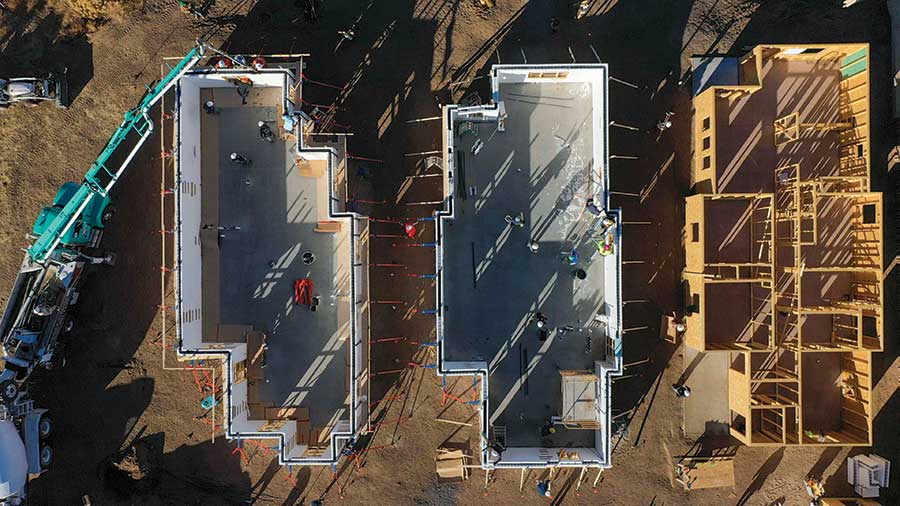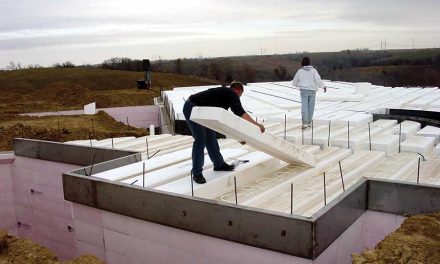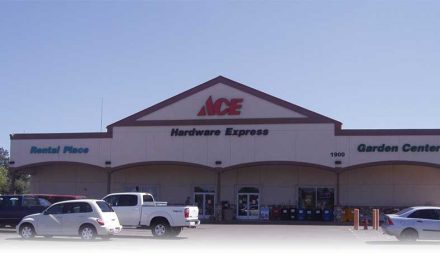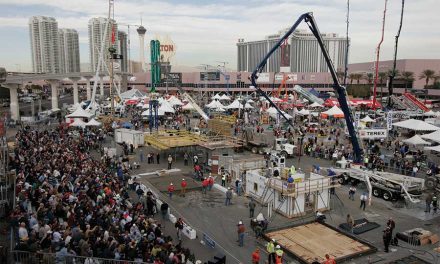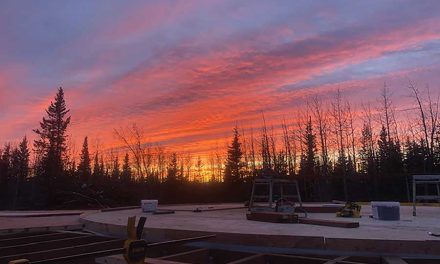An aerial view of 2021 Habitat for Humanity homes in Santa Fe, New Mexico. Two are ICFs and one is wood.
Green building is one of those catch-all phrases that means something different to everyone. The clearest definition of green building is a process to minimize the negative impact of buildings on the environment while creating healthy, sustainable, resilient, and efficient spaces for people to live and work. Especially in construction, customers want to understand if the product they’re choosing really does live up to its promises. So, what makes ICFs really green? There are six common areas we can use to evaluate building materials and more specifically ICFs: energy efficiency, water conservation, sustainable materials, indoor air quality, site selection, and waste reduction.
Energy Efficiency
The last few decades have brought so many options in terms of creating more energy efficiency in construction; everything from improving the building envelope to developing onsite energy management strategies after construction. Each one of the primary goals of green building design is to reduce energy consumption by minimizing the amount of energy required to heat, cool, and light buildings. Energy efficiency requirements continue to increase in every code cycle revision. ICFs meet and exceed those requirements today.
ICFs create an insulated solid-mass building envelope that is airtight and combines several construction steps in a single technology. This brings the unique benefit of reducing complexity in construction and eliminating additional products to create a superior result. Because of the insulated thermal mass of the concrete, an ICF wall provides greater insulation performance than traditional materials can achieve without significant additional complexity and cost. Achieving similar insulation values using traditional construction requires building the same traditional structure then sealing every seam, adding additional continuous insulation, and other materials. Each of these choices can lead to more challenges to manage moisture, air quality, and long-term maintenance.
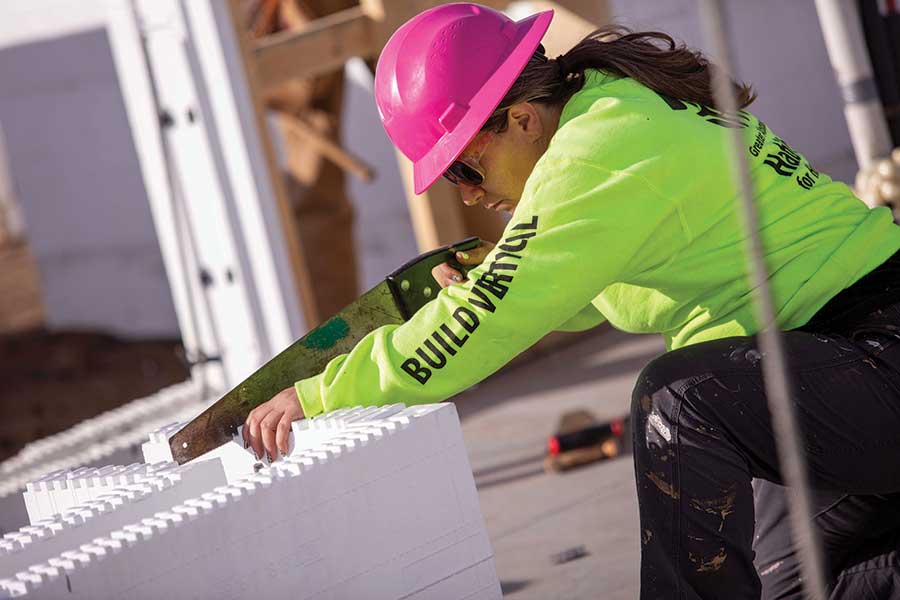
Working on the Habitat for Humanity home in Santa Fe. (Photos courtesy of the Insulating Concrete Forms Manufacturers Association)
Water Conservation
Water conservation might not be an area that you would initially consider when evaluating building materials. Low-flow fixtures, water-efficient landscaping, and other measures that conserve water and prevent waste are prevalent after a home is built, but what about during construction? Traditional building materials consume a great amount of water during cultivation and processing to become building materials.
How do ICFs help? ICFs are made using steam to expand the EPS bead, but much of that water is recovered and recycled during the manufacturing process. Concrete uses about 32 gallons per yard, but of that water, roughly half either seeps back into the ground (9 gallons per yard) or evaporates (8 gallons per yard).
Additionally, ICFs can help to reduce water usage within buildings. The high insulation provided by ICFs can help to maintain a consistent indoor temperature, reducing the need for heating and cooling. This can in turn reduce the amount of water used for air conditioning, humidification, and dehumidification, especially in larger buildings.
Sustainable Materials
Green buildings use sustainable materials that minimize the impact on the environment. ICFs again add to sustainability during and after the construction process. ICFs use very few materials, and about 50% of the material is recycled plastic for the web ties. There are very few insulating materials that perform as well as EPS, so the carbon that is consumed in the material is put to a great purpose, insulating a structure. The inherent resilience of ICF structures also increases the sustainability of ICFs. Life cycle analysis of materials continues to be a hot topic for materials, and since ICFs are made of durable plastics and concrete, these structures have the potential to survive for hundreds of years, thus increasing their sustainable contribution. ICF structures also withstand extreme weather events, are more seismically resilient, and provide habitable space for longer periods with the loss of power and other utility services. Even when damaged, ICFs may need a repair or a remodel versus a complete rebuild.
Indoor Environmental Quality
Another goal of green building is providing a healthy and comfortable indoor environment. ICFs create an airtight wall and, when properly designed with roof and openings, an ICF structure can have a stable interior air quality. Since the structure is not actively breathing, dust, dirt, allergens, and other pollutants are kept out of the structure. Many ICF homes and buildings also utilize Heat Recovery Ventilation (HRV) or Energy Recovery Ventilation (ERV) to capture wasted energy from exhaust air to preheat fresh air coming into the structure. The primary difference is that ERVs go a step further and can reduce humidity levels as well in more humid
environments.
Site Selection and Development
Green building also takes into account the site selection and development process. One of the unique benefits of ICFs is the ease of which ICFs can be used to build in areas that traditional building materials struggle with. Inherent in ICF construction is an extremely strong material that can be built in a variety of challenging environments, from poor soil types, complex topography, coastal high wind zones, loud acoustic areas, among other challenges.
ICFs can be effectively used in complex environments, where other traditional materials may not be well suited. This can give residents the peace of mind, knowing their investment has the best shot at dealing with mother nature.
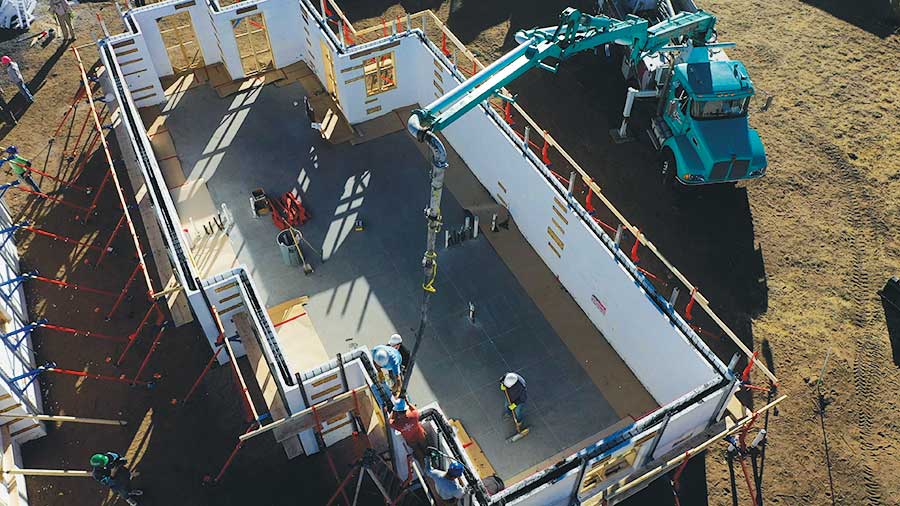
A close-up of the ICF Habitat for Humanity home.
Waste Reduction
A key principle of green building and design also focuses on minimizing construction waste and diverting waste from landfills through recycling. ICFs are one of the lowest-waste construction products. When jobs are planned well there can be very little “scrap,” and what is left over is often still usable as insulation infill in walls. Since ICFs also combine so many construction steps, they reduce other products used and eliminate further waste generated from shipping and packaging. The reduction in complexity and supply chain demands streamlines the building process.
Slowing the Roll
ICFs can contribute to water conservation by reducing water usage during construction, reducing energy demand and water usage in energy production, and reducing water usage within buildings. They provide more locations where structures can be built and are more resilient in areas that are subject to extreme weather events or other hazards. Add extreme energy-efficiency and ease of use and ICFs continue to contribute to truly green construction that will deliver benefits for decades. The long-term cost savings and environmental benefits make them a smart investment for those looking to build green.

Brian Corder
Brian Corder is the marketing chair of the Insulating Concrete Forms Manufacturers Association (ICFMA, www.icf-ma.org) and the president and CEO of BuildBlock Building Systems (www.buildblock.com).

